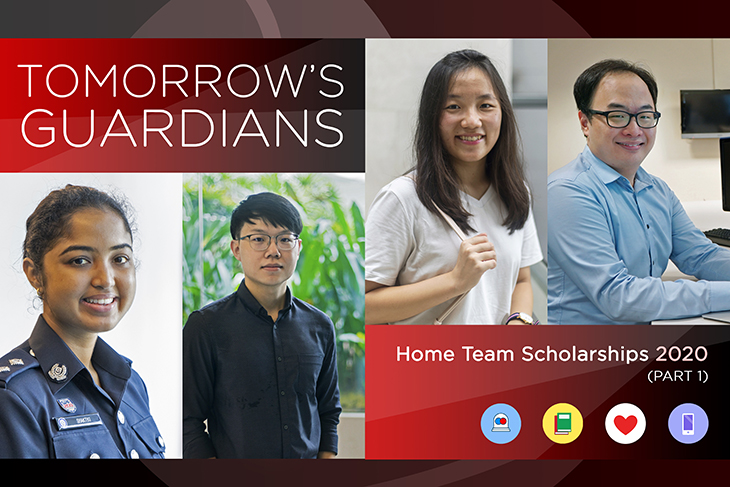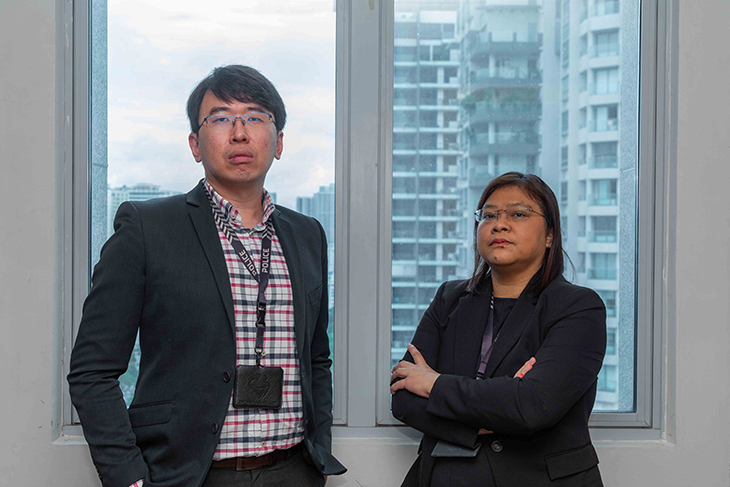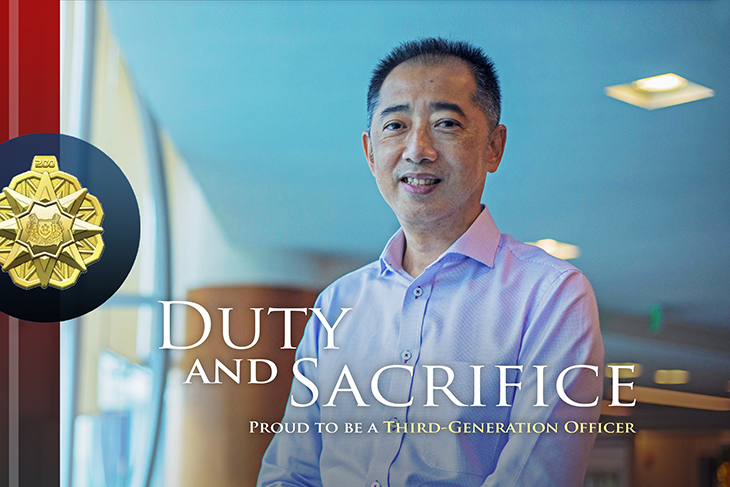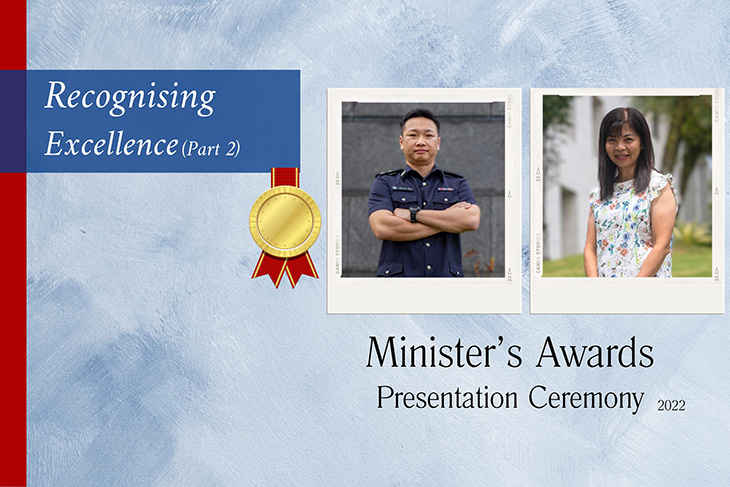 TRANSFORMING CARGO CLEARANCE
TRANSFORMING CARGO CLEARANCE
Deputy Superintendent (DSP) Chew Aik Tong
Deputy Head, Projects Office (Sea), Operations Division, Immigration & Checkpoints Authority (ICA) Recipient of the Home Team Achievement Award (HTAA)One of the six projects that received the HTAA was the “On-the-Fly” Clearance initiative at Tuas Port. As part of the team that implemented the project from conceptualisation to operationalisation, DSP Chew shares his involvement in transforming cargo clearance through automation and strengthening ICA’s capability to detect and prevent undesirable cargo from crossing our borders – important in securing Singapore’s position as a strategic global port. 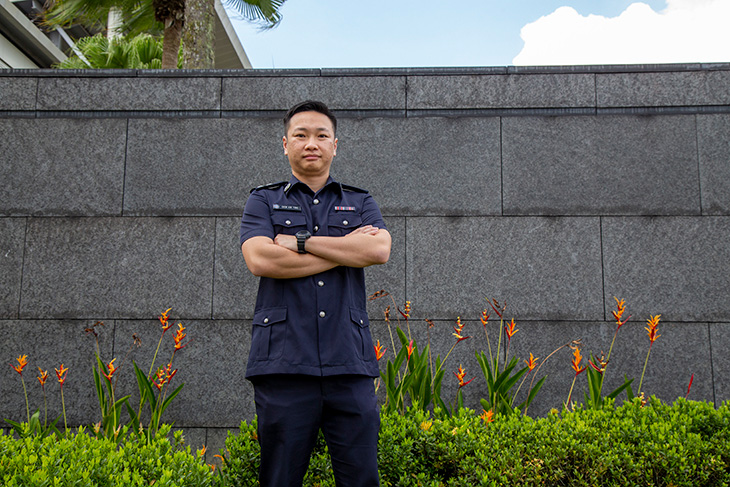
DSP Chew. PHOTO: Arvind Chan
Tell us more about ICA’s “On-the-Fly” initiative! As part of the New Clearance Concept (NCC), ICA implemented the “On-the-Fly” Clearance initiative at Tuas Port since October 2021.
As the name “On-the-Fly” implies, cargo containers from incoming vessels will be processed in real-time and no longer need to proceed to a holding area to wait for the scan results.
To achieve this, we placed the Radiographic Scanning Portal (RSP) closer to the pier to enable containers to be scanned earlier. Drivers will have the containers loaded on their vehicles and continue to drive towards the exit after going through the RSP. They will be notified of their scan results via a mobile device onboard their vehicle. Those with anomalies in their scanned images will be directed to the Cargo Inspection Centre for further checks. Those without anomalies will proceed to exit Tuas Port.
This ‘On-the-Fly’ Clearance process has reduced the cargo clearance timing from approximately 14 minutes to three minutes.
What is NCC Cargo and how does it improve the cargo clearance process at the checkpoints?NCC Cargo is part of ICA’s transformation strategy to manage the increasing cargo volume at our checkpoints. The cargo volume handled across our checkpoints is expected to increase significantly in the next two decades, with new infrastructure development such as the Changi East Industrial Zone. Hence, it is timely to introduce NCC Cargo to meet the growing cargo volume by automating clearance and enhancing operational efficiency.
Apart from the ‘On-the-Fly’ Clearance, another initiative implemented was the Mobile Cargo Screening System (Mobile CASS), a mobile device that allows our officers to access cargo information and supporting documents without the need to return to the duty office. This allows our officers to validate cargo permits on the spot and further reduces the waiting time for drivers.
Another initiative is the collaboration with Singapore Customs to provide a paperless cargo clearance process for conventional cargo. With this, drivers will no longer need to print out hardcopy permits and supporting documents.
On top of providing a seamless and efficient clearance experience, we also need to ensure a secure clearance process. To do this, we are exploring the use of artificial intelligence and data analytics to strengthen our detection capability and prevent prohibited and contraband items from entering Singapore.
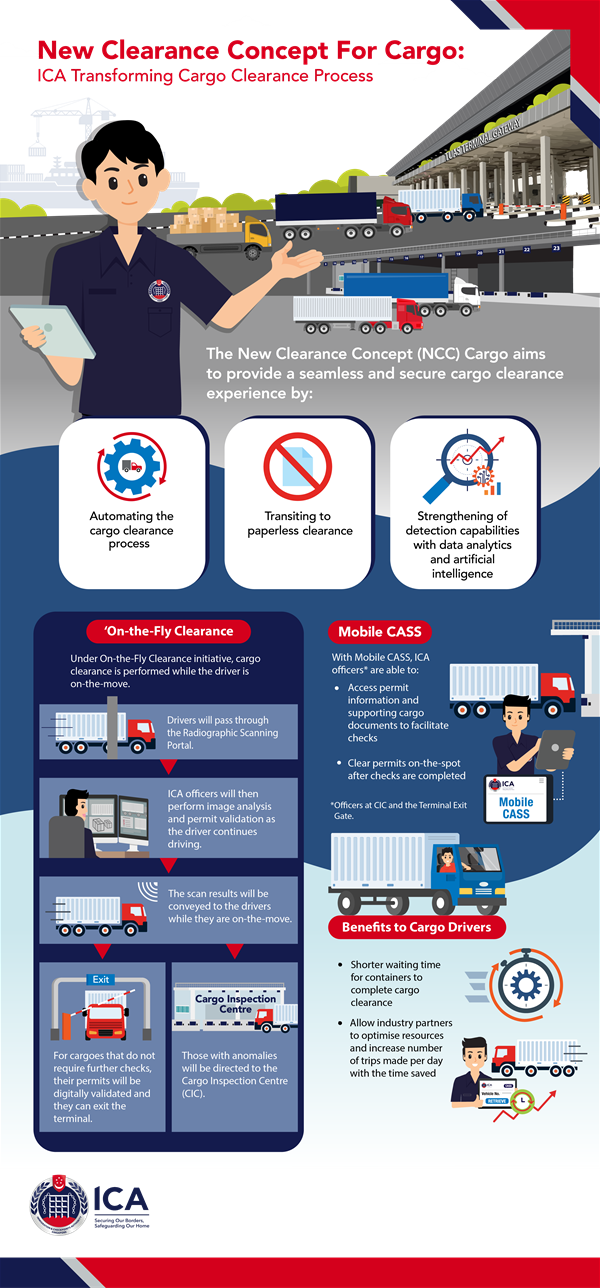
Overview of the process of NCC Cargo. GRAPHIC: ICA
What were some challenges that the project team faced in rolling out the initiative?Being a completely new concept for cargo clearance at sea ports, the team had to engage all stakeholders internally within ICA, externally with port operator PSA, as well as solutioning experts from our fellow Home Team Department -
Home Team Science and Technology Agency (HTX). Other than the engagement of stakeholders, it was also a long-drawn process - conceptualisation commenced in 2018 and involved many rounds of discussion to iron out the issues that surfaced along the way.
Our implementation progress hit a snag when countries closed their borders due to the COVID-19 pandemic. We faced shipping delays and shortage in construction manpower along with the rest of the world.
Despite these roadblocks, I am thankful for the support of all stakeholders who put in extra effort and resources – working overtime to make up for the various delays to the project timeline, and attending urgent meetings after office hours to resolve unexpected issues – that we could successfully launch the first phase of Tuas Port in October 2022.
– By Elaine Lee
TACKLING THE PANDEMIC WITH INNOVATION Dr Oh Hue Kian
Principal CBRNE Scientist, Chemical, Biological Radiological, Nuclear and Explosive (CBRNE) Centre of Expertise, Home Team Science and Technology Agency (HTX)
Recipient of Home Team Innovation Award (InnovA Champion – Platinum)The Home Team Innovation Award (InnovA) recognises exceptional Home Team officers in the area of innovation. As one of only two Platinum recipients, Dr Oh co-developed the Lab-On-Chip for the detection of SARS-CoV-2 during the early days of the COVID-19 pandemic and supported the national testing efforts of travellers at various checkpoints.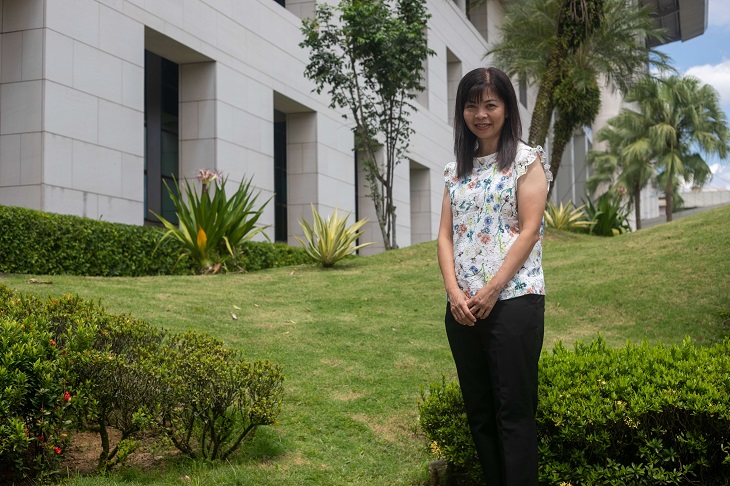
Dr Oh Hue Kian. PHOTO: Benedict Kok.
Tell us more about the Lab-On-Chip (LOC). To secure Singapore’s borders against COVID-19, my colleagues and I worked with our partner, Veredus Laboratories, to co-develop the LOC for the detection of SARS-COV-2 (COVID-19). It was used at all checkpoints to screen travellers entering Singapore since 5 March 2020.
The LOC can perform two powerful molecular biology technologies, namely the Polymerase Chain Reaction (PCR) (for rapid amplification of a specific segment of DNA) and microarray (for detection of target genes expression and sequence) on a single microchip the size of a fingernail.
What is the difference between LOC and PCR testing for COVID-19?The LOC can detect many virus targets at the same time on the same panel, while a real-time PCR detects a maximum of five targets, beyond which the sensitivity may be compromised. The LOC can simultaneously screen for various COVID-19 mutations and the presence of other related viruses, which increases operational efficiency.
What was a key challenge when co-developing the Lab-On-Chip, and how did you overcome it?One challenge was in ensuring that the LOC's results were accurate. Due to the LOC’s multifunctionality, we needed to ensure that its sensitivity to the COVID-19 virus was not significantly lesser than the PCR. However, there were limited positive COVID-19 samples available during the early days of the pandemic. Our team would use the LOC concurrently with the PCR-testing for human swab samples, and check that the results from LOC tally with the results from PCR assays. Based on the feedback gathered, we fine-tuned our processes and enhanced the LOC design with Veredus Laboratories.
You also helped HTX’s CBRNE lab obtain the Private Hospitals and Medical Clinics license in August 2022 (currently known as the Healthcare Service Act License). Why was it important for the lab to obtain the license?
The Ministry of Health mandates the laboratories that perform human clinical sample testing to be licensed. The license is typically issued to clinics and medical institutions for the analysis of clinical samples. For HTX to support border swab analysis of travellers for the various checkpoints, we had to be licensed. Obtaining the license is a recognition of our staff competency, lab capability and an acknowledgement to the high standards we deliver.
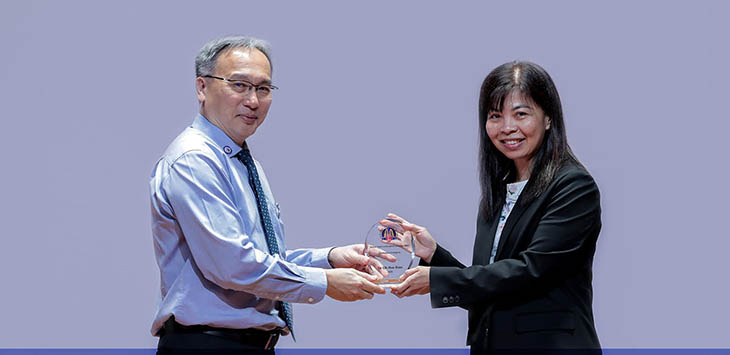
Dr Oh receiving the InnovA from MHA Permanent Secretary Pang Kin Keong. PHOTO: MHA
What do you enjoy about the innovation process? Innovation begins with brainstorming ideas for a problem statement and subsequently conducting a lot of experimentation to shortlist the best solution to the problem. During the process, many questions could arise, and it will prompt me to dive deeper by reading or conducting more experimentation to learn more. The learnings and new findings are exactly what I enjoy most during the process.
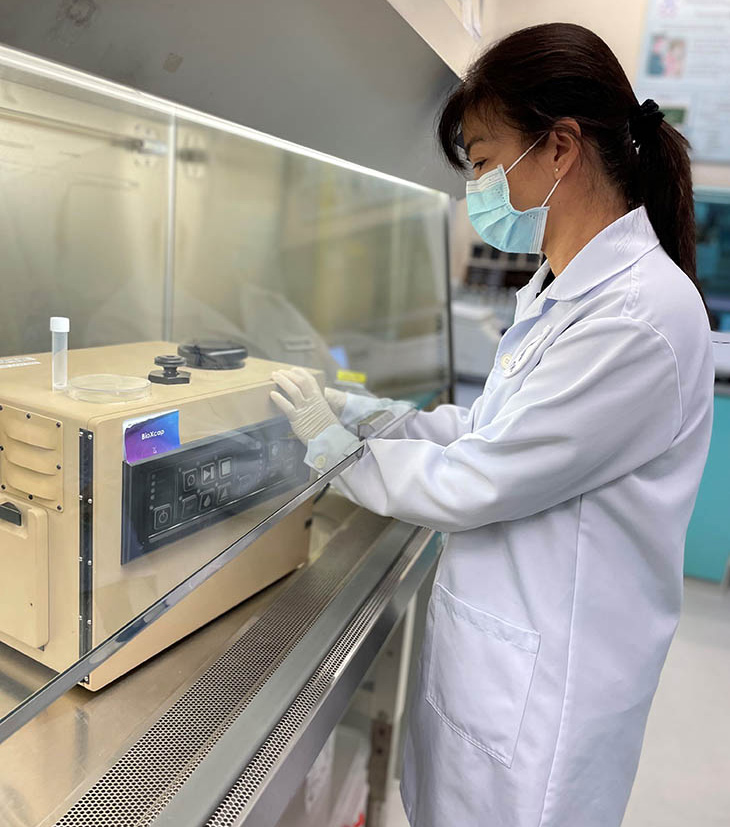
Dr Oh at work in her lab. PHOTO: HTX
What new innovations are you working on? My colleague and I are working on an autonomous way of conducting bio-surveillance and also a new and faster way of detecting unknown biological threat. We will share more in future when the methodology is ready.
Why do you continue to love what you do?It gives me the sense of achievement when my work is used for a good cause to help others and even greater good when it can be applied to keeping Singapore safe.
- By Tham Yee Lin
Minister’s Awards Presentation Ceremony The annual Minister’s Awards Presentation Ceremony was held on 17 January 2023 to recognise outstanding officers, teams and agencies that had demonstrated efficiency and competency in major operations, cases and projects, or displayed high standards of innovation and service excellence in the course of their work in 2022.
Two hundred and two awards were presented in the following categories: Minister for Home Affairs Home Team Achievement Award, Minister for Home Affairs Operational Excellence Award, Star Service Award and Home Team Innovation Award.
Read the
speech by Mr K Shanmugam, Minister for Home Affairs and Minister for Law, at the Minister's Awards Presentation Ceremony 2022.








